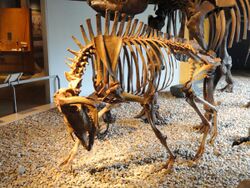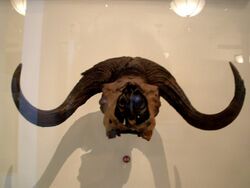Biology:Bootherium bombifrons
| Bootherium bombifrons | |
|---|---|

| |
| Bootherium bombifrons | |
| Scientific classification | |
| Domain: | Eukaryota |
| Kingdom: | Animalia |
| Phylum: | Chordata |
| Class: | Mammalia |
| Order: | Artiodactyla |
| Family: | Bovidae |
| Subfamily: | Caprinae |
| Genus: | †Bootherium Leidy, 1852 |
| Species: | †B. bombifrons
|
| Binomial name | |
| †Bootherium bombifrons (Harlan, 1825)
| |
| Synonyms | |
|
Symbos cavifrons | |
Bootherium is an extinct bovid genus from the middle to late Pleistocene of North America which contains a single species, Bootherium bombifrons.[1] Vernacular names for Bootherium include Harlan's muskox, woodox, woodland muskox,[2] helmeted muskox,[3] or bonnet-headed muskox.[4] Bootherium was one of the most widely distributed muskox species in North America during the Pleistocene era.
Taxonomy
Fossils have been documented from Alaska to California and Texas , Missouri, Oklahoma, Virginia, North Carolina and New Jersey. The species became extinct approximately 11,000 years ago at the end of the last ice age.[2]
The closest relative of Bootherium is the extant muskox Ovibos moschatus. However, unlike the tundra muskox, Bootherium was physically adapted to a range of less frigid climates and appears to have been the only ox to have evolved in and remain restricted to the North American continent.[2] Bootherium was significantly taller and leaner than muskoxen found today in Arctic regions. Bootherium were estimated to weigh around 423.5 kg (934 lb).[5] Other differences were a thicker skull and considerably longer snout. The horns of Bootherium were situated high on the skull, with a downward curve and were fused along the midline of the skull, unlike tundra muskoxen whose horns are separated by a medial groove. An almost complete mummified specimen was found in 1940.[6]
Three other species of musk oxen co-inhabited North America during the Pleistocene era. Besides the surviving tundra muskox, the extinct shrub-ox (Euceratherium collinum) and Soergel's ox (Soergelia mayfieldi) were also present.
Notes
- ↑ McKenna & Bell, 1997, p. 442.
- ↑ 2.0 2.1 2.2 The Academy of Natural Sciences
- ↑ Helmeted Muskox (Bootherium bombifrons) from Near Fort Saskatchewan, Alberta: Dating Evidence for Redeposition in Late Pleistocene Alluvium
- ↑ Martin, Paul S. (1999). "War Zones and Game Sinks in Lewis and Clark's West". Conservation Biology 13: 36–45. doi:10.1046/j.1523-1739.1999.97417.x.
- ↑ Paleobiology Database: Bootherium bombifrons
- ↑ Guthrie, R. Dale (1990). Frozen Fauna of the Mammoth Steppe The Story of Blue Babe. University of Chicago Press. ISBN 978-0-226-31123-4. https://books.google.com/books?id=cuQhsNQcKMYC.
References
- McKenna, Malcolm C.; Bell, Susan K. (1997). Classification of Mammals Above the Species Level. ISBN 978-0-231-11013-6.
External links
- http://nature.ca/notebooks/english/helmet.htm
- https://web.archive.org/web/20080407140851/http://www.ansp.org/museum/jefferson/otherFossils/bootherium.php
Wikidata ☰ Q1603113 entry


